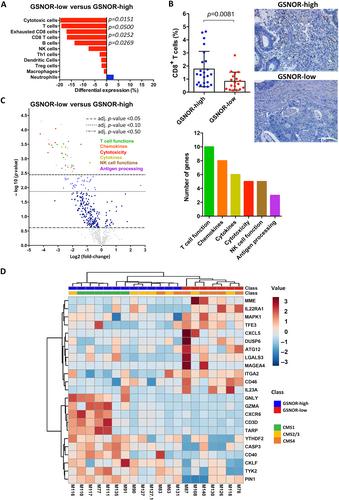下载PDF
{"title":"代谢转移是s -亚硝基谷胱甘肽还原酶缺乏癌症的肿瘤进展和免疫逃避的基础","authors":"Rafael Mena-Osuna, Ana Mantrana, Silvia Guil-Luna, María Teresa Sánchez-Montero, Carmen Navarrete-Sirvent, Teresa Morales-Ruiz, Aurora Rivas-Crespo, Marta Toledano-Fonseca, María Victoria García-Ortíz, Gema García-Jurado, María Auxiliadora Gómez-España, Rafael González-Fernández, Carlos Villar, Francisco Javier Medina-Fernández, José Manuel Villalba, Enrique Aranda, Antonio Rodríguez-Ariza","doi":"10.1002/path.6080","DOIUrl":null,"url":null,"abstract":"<p>S-nitrosoglutathione reductase (GSNOR) is a denitrosylase enzyme that has been suggested to play a tumor suppressor role, although the mechanisms responsible are still largely unclear. In this study, we show that GSNOR deficiency in tumors is associated with poor prognostic histopathological features and poor survival in patients with colorectal cancer (CRC). GSNOR-low tumors were characterized by an immunosuppressive microenvironment with exclusion of cytotoxic CD8<sup>+</sup> T cells. Notably, GSNOR-low tumors exhibited an immune evasive proteomic signature along with an altered energy metabolism characterized by impaired oxidative phosphorylation (OXPHOS) and energetic dependence on glycolytic activity. CRISPR-Cas9-mediated generation of GSNOR gene knockout (KO) CRC cells confirmed <i>in vitro</i> and <i>in vivo</i> that GSNOR-deficiency conferred higher tumorigenic and tumor-initiating capacities. Moreover, GSNOR-KO cells possessed enhanced immune evasive properties and resistance to immunotherapy, as revealed following xenografting them into humanized mouse models. Importantly, GSNOR-KO cells were characterized by a metabolic shift from OXPHOS to glycolysis to produce energy, as indicated by increased lactate secretion, higher sensitivity to 2-deoxyglucose (2DG), and a fragmented mitochondrial network. Real-time metabolic analysis revealed that GSNOR-KO cells operated close to their maximal glycolytic rate, as a compensation for lower OXPHOS levels, explaining their higher sensitivity to 2DG. Remarkably, this higher susceptibility to glycolysis inhibition with 2DG was validated in patient-derived xenografts and organoids from clinical GSNOR-low tumors. In conclusion, our data support the idea that metabolic reprogramming induced by GSNOR deficiency is an important mechanism for tumor progression and immune evasion in CRC and that the metabolic vulnerabilities associated with the deficiency of this denitrosylase can be exploited therapeutically. © 2023 The Authors. <i>The Journal of Pathology</i> published by John Wiley & Sons Ltd on behalf of The Pathological Society of Great Britain and Ireland.</p>","PeriodicalId":232,"journal":{"name":"The Journal of Pathology","volume":"260 3","pages":"261-275"},"PeriodicalIF":5.6000,"publicationDate":"2023-04-05","publicationTypes":"Journal Article","fieldsOfStudy":null,"isOpenAccess":false,"openAccessPdf":"https://onlinelibrary.wiley.com/doi/epdf/10.1002/path.6080","citationCount":"1","resultStr":"{\"title\":\"Metabolic shift underlies tumor progression and immune evasion in S-nitrosoglutathione reductase-deficient cancer\",\"authors\":\"Rafael Mena-Osuna, Ana Mantrana, Silvia Guil-Luna, María Teresa Sánchez-Montero, Carmen Navarrete-Sirvent, Teresa Morales-Ruiz, Aurora Rivas-Crespo, Marta Toledano-Fonseca, María Victoria García-Ortíz, Gema García-Jurado, María Auxiliadora Gómez-España, Rafael González-Fernández, Carlos Villar, Francisco Javier Medina-Fernández, José Manuel Villalba, Enrique Aranda, Antonio Rodríguez-Ariza\",\"doi\":\"10.1002/path.6080\",\"DOIUrl\":null,\"url\":null,\"abstract\":\"<p>S-nitrosoglutathione reductase (GSNOR) is a denitrosylase enzyme that has been suggested to play a tumor suppressor role, although the mechanisms responsible are still largely unclear. In this study, we show that GSNOR deficiency in tumors is associated with poor prognostic histopathological features and poor survival in patients with colorectal cancer (CRC). GSNOR-low tumors were characterized by an immunosuppressive microenvironment with exclusion of cytotoxic CD8<sup>+</sup> T cells. Notably, GSNOR-low tumors exhibited an immune evasive proteomic signature along with an altered energy metabolism characterized by impaired oxidative phosphorylation (OXPHOS) and energetic dependence on glycolytic activity. CRISPR-Cas9-mediated generation of GSNOR gene knockout (KO) CRC cells confirmed <i>in vitro</i> and <i>in vivo</i> that GSNOR-deficiency conferred higher tumorigenic and tumor-initiating capacities. Moreover, GSNOR-KO cells possessed enhanced immune evasive properties and resistance to immunotherapy, as revealed following xenografting them into humanized mouse models. Importantly, GSNOR-KO cells were characterized by a metabolic shift from OXPHOS to glycolysis to produce energy, as indicated by increased lactate secretion, higher sensitivity to 2-deoxyglucose (2DG), and a fragmented mitochondrial network. Real-time metabolic analysis revealed that GSNOR-KO cells operated close to their maximal glycolytic rate, as a compensation for lower OXPHOS levels, explaining their higher sensitivity to 2DG. Remarkably, this higher susceptibility to glycolysis inhibition with 2DG was validated in patient-derived xenografts and organoids from clinical GSNOR-low tumors. In conclusion, our data support the idea that metabolic reprogramming induced by GSNOR deficiency is an important mechanism for tumor progression and immune evasion in CRC and that the metabolic vulnerabilities associated with the deficiency of this denitrosylase can be exploited therapeutically. © 2023 The Authors. <i>The Journal of Pathology</i> published by John Wiley & Sons Ltd on behalf of The Pathological Society of Great Britain and Ireland.</p>\",\"PeriodicalId\":232,\"journal\":{\"name\":\"The Journal of Pathology\",\"volume\":\"260 3\",\"pages\":\"261-275\"},\"PeriodicalIF\":5.6000,\"publicationDate\":\"2023-04-05\",\"publicationTypes\":\"Journal Article\",\"fieldsOfStudy\":null,\"isOpenAccess\":false,\"openAccessPdf\":\"https://onlinelibrary.wiley.com/doi/epdf/10.1002/path.6080\",\"citationCount\":\"1\",\"resultStr\":null,\"platform\":\"Semanticscholar\",\"paperid\":null,\"PeriodicalName\":\"The Journal of Pathology\",\"FirstCategoryId\":\"3\",\"ListUrlMain\":\"https://onlinelibrary.wiley.com/doi/10.1002/path.6080\",\"RegionNum\":2,\"RegionCategory\":\"医学\",\"ArticlePicture\":[],\"TitleCN\":null,\"AbstractTextCN\":null,\"PMCID\":null,\"EPubDate\":\"\",\"PubModel\":\"\",\"JCR\":\"Q1\",\"JCRName\":\"ONCOLOGY\",\"Score\":null,\"Total\":0}","platform":"Semanticscholar","paperid":null,"PeriodicalName":"The Journal of Pathology","FirstCategoryId":"3","ListUrlMain":"https://onlinelibrary.wiley.com/doi/10.1002/path.6080","RegionNum":2,"RegionCategory":"医学","ArticlePicture":[],"TitleCN":null,"AbstractTextCN":null,"PMCID":null,"EPubDate":"","PubModel":"","JCR":"Q1","JCRName":"ONCOLOGY","Score":null,"Total":0}
引用次数: 1
引用
批量引用



